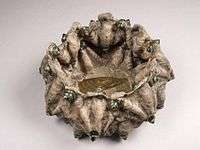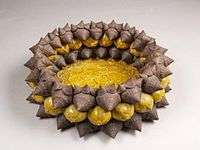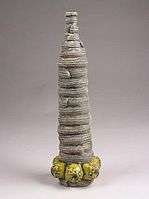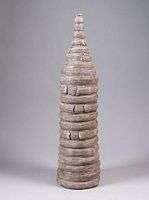Wietske van Leeuwen
| Wietske van Leeuwen | |
|---|---|
 Wietske van Leeuwen in Paris, 1988. | |
| Born |
22 September 1965 Rotterdam, Netherlands |
| Nationality | Dutch |
| Education | Gerrit Rietveld Academy |
| Known for | Ceramics |
Wietske van Leeuwen (born September 22, 1965 in Rotterdam) is a Dutch ceramist,[1] who lives and works in Monnickendam. Her works are constructed in a baroque style, with shells and fruit as recurring motifs.[2]
Life and work
Born in Rotterdam to Sjoerd and Marianne van Leeuwen, Van Leeuwen grew up in Mijnsheerenland. Her father ran a timber trading company in Overschie, and her uncle is the photographer Piet van Leeuwen (born 1942).[3] She studied handicrafts and textile art at the teacher training college in Delft from 1984 to 1989, and ceramic design at the Gerrit Rietveld Academy in Amsterdam from 1989 to 1993[4] under Jan van der Vaart, and Henk Trumpie.[5]
After graduation she settled in Amsterdam as an independent artist and started her own studio. In 1996 Van Leeuwen was nominated for the NPS Cultuurprijs 1996, a battle between young unknown artists which was aired on national television.[6][7]
Van Leeuwen received a number of grants from the Mondriaan Fonds, the Dutch fund for visual art and cultural heritage. Since 1997 she is also working as a ceramics and drawing teacher at Altra College, Amsterdam.
Van Leeuwen's work is included in the collection of the Gemeentemuseum Den Haag,[8] the Museum Boijmans Van Beuningen in Rotterdam,[9] and the Princessehof Ceramics Museum.
Photo Gallery
 Shell bowl with deepsea pike, 1993
Shell bowl with deepsea pike, 1993 Scale with matt brown side, 1995
Scale with matt brown side, 1995.jpg) Green glass bowl, 1997
Green glass bowl, 1997.jpg) Terrine with lid, 1997
Terrine with lid, 1997 Vase with cactus fruits, 2000
Vase with cactus fruits, 2000 Bear claw pot, 2007
Bear claw pot, 2007
Reception
At the Studio Pottery website the Dutch Galery Carla Koch (2008) gave the following description of the motives in the work and motivation behind the work:
- Van Leeuwen creates strikingly baroque objects, made up of many small prints of shells and fruit, which remind of the curio cabinets that were in fashion in the 17th century and admired by her. It was in vogue among the wealthy merchants of that era to collect new types of fruit and shells that were brought back by the VOC ships, in such cabinets. Van Leeuwen uses shells and fruit to make plaster press moulds, which are then used for producing large quantities of prints. From these prints she creates her objects, always using the pot or dish shape as a basis. Her objects are flawless both on the inside and outside, a ceramic tour de force. She uses dishes and pots with lids as her base shapes. In addition, she creates combinations of ceramic "garnitures", which were also common during the 17th century."[2]
In 2010 the Kunsthal exhibited modern ceramic art collection of Museum Boijmans Van Beuningen with works of multiple generations of Dutch ceramists. Work was shown from the beginning of the 20th century with Chris Lanooij (1881-1948) and Hein Andrée (1882-1961), more contemporary artists as Johan van Loon (1934), Jan van der Vaart (1931-2000), Barbara Nanning (1957), Geert Lap and Olaf Stevens, and work by Esther Stasse and Wietske van Leeuwen representing the last generation.[10]
See also
References
- ↑ Biographical data at the Netherlands Institute for Art History
- 1 2 "Galerie Carla Koch; Wietske van Leeuwen," at studiopottery.co.uk, 2008-17
- ↑ Piet van Leeuwen (1942-) at the Netherlands Institute for Art History.
- ↑ Curriculum Vitae at wietskevanleeuwen.nl. Accessed 22.05.2015.
- ↑ Press release "Jan van der Vaart en leerlingen," in Galerie Carla Koch, Delft 2005. Accessed 15.05.2015.
- ↑ Simone van der Burg. "Jong talent strijdt om nieuwe NPS-cultuurprijs: De NPS-cultuurprijs, wekelijks vanaf woensdag 17 juli, Ned.3, 20.55u.," NRC Handelsblad 16.07. 1996
- ↑ Fragments of NPS-cultuurprijs, 1996 at flickr.com (in Dutch). Accessed 22.04.2017.
- ↑ Marjan Boot. "Aanwinsten eigentijdse vormgeving," in: Haags Gemeente Museumkrant, 1993.
- ↑ "In the rough : images of nature through the ages in the collection of the Boijmans Van Beuningen Museum; January 13 through April 1, 2001." Fundação de Serralves, 2001
- ↑ "KLEIKUNST, STEENGOED! Keramiek uit Museum Boijmans Van Beuningen 24 april t/m 15 augustus 2010," webtext at kunsthal.nl, 2010.
External links
| Wikimedia Commons has media related to Wietske van Leeuwen. |
- (in Dutch) Official website
- (in Dutch) Leeuwen, Wietske van at capriolus.nl